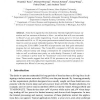Free Online Productivity Tools
i2Speak
i2Symbol
i2OCR
iTex2Img
iWeb2Print
iWeb2Shot
i2Type
iPdf2Split
iPdf2Merge
i2Bopomofo
i2Arabic
i2Style
i2Image
i2PDF
iLatex2Rtf
Sci2ools
126
Voted
EWSN
2012
Springer
2012
Springer
Low Power or High Performance? A Tradeoff Whose Time Has Come (and Nearly Gone)
Abstract. Some have argued that the dichotomy between high-performance operation and low resource utilization is false – an artifact that will soon succumb to Moore’s Law and careful engineering. If such claims prove to be true, then the traditional 8/16- vs. 32-bit power-performance tradeoffs become irrelevant, at least for some low-power embedded systems. We explore the veracity of this thesis using the 32-bit ARM Cortex-M3 microprocessor and find quite substantial progress but not deliverance. The Cortex-M3, compared to 8/16-bit microcontrollers, reduces latency and energy consumption for computationally intensive tasks as well as achieves near parity on code density. However, it still incurs a ∼2× overhead in power draw for “traditional” sense-store-send-sleep applications. These results suggest that while 32-bit processors are not yet ready for applications with very tight power requirements, they are poised for adoption everywhere else. Moore’s Law may yet prevail.
| Added | 21 Apr 2012 |
| Updated | 21 Apr 2012 |
| Type | Journal |
| Year | 2012 |
| Where | EWSN |
| Authors | JeongGil Ko, Kevin Klues, Christian Richter, Wanja Hofer, Branislav Kusy, Michael Brünig, Thomas Schmid, Qiang Wang, Prabal Dutta, Andreas Terzis |
Comments (0)

